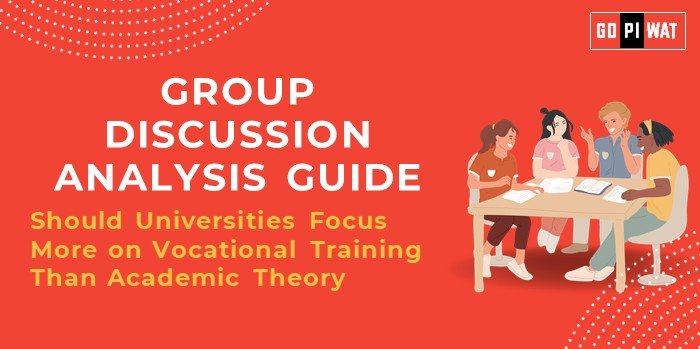📋 GD Guide: Should Universities Focus More on Vocational Training Than Academic Theory?
🌐 Introduction to the Topic
Opening Context: Globally, debates about the relevance of university education often center on the balance between academic theory and vocational training. As economies evolve to prioritize skill-based roles, this topic becomes critical for B-school aspirants evaluating education’s impact on employability.
Topic Background: Traditionally, universities emphasized theoretical learning, fostering research and critical thinking. However, the rising demand for job-ready graduates, coupled with industry dissatisfaction with skill gaps, has rekindled interest in vocational education.
📊 Quick Facts and Key Statistics
– 💼 Vocational Training Enrollment (India): 5% of students – Indicates the limited scope of skill-based education in comparison to global averages like Germany’s 60%.
– 🌍 Global Skill Gap Costs (2023): $8.5 trillion annually – Reflects the economic implications of workforce misalignment.
– 🇮🇳 Indian Government Initiatives: 100+ Skill India programs launched since 2015 to boost employability.
👥 Stakeholders and Their Roles
- 🏛️ Government: Policies for skill development, vocational courses integration.
- 🏫 Universities: Curriculum design, balancing theoretical and practical knowledge.
- 💼 Employers: Feedback on industry needs and partnerships with academia.
- 👨🎓 Students: Advocates for employability and career relevance.
- 🌐 International Organizations: Insights and funding for skill-development programs.
🏆 Achievements and Challenges
✨ Achievements:
- ✔️ Successful skill programs like Germany’s dual-education model integrate academic and vocational learning effectively.
- ✔️ Indian initiatives like Pradhan Mantri Kaushal Vikas Yojana (PMKVY) trained over 12 million youth in vocational skills.
⚠️ Challenges:
- 🚧 Lack of infrastructure for vocational training in many universities.
- 🚧 Resistance from academic institutions to shift focus from traditional theory.
🌍 Global Comparisons:
- 🇩🇪 Germany: Exemplifies the success of vocational training, with lower youth unemployment.
- 🇰🇷 South Korea: Focus on STEM and vocational courses enhanced employability.
Case Study:
– TISS-SVE (India): The School of Vocational Education (SVE) integrates industry demand into curricula, enhancing job readiness.
💡 Structured Arguments for Discussion
✔️ Supporting Stance:
“Vocational training equips students with job-ready skills, addressing skill gaps and unemployment effectively.”
❌ Opposing Stance:
“Academic theory is critical for fostering innovation, leadership, and problem-solving skills essential for long-term career growth.”
⚖️ Balanced Perspective:
“A hybrid approach combining theory with practical skills is necessary for holistic development.”
🧠 Effective Discussion Approaches
📝 Opening Approaches:
- 📊 Data-Driven Start: “With only 5% of Indian students enrolled in vocational training, a critical skills gap threatens employability.”
- 📚 Case Study Opening: “Germany’s dual-education system demonstrates how vocational focus can complement theoretical learning.”
🛠️ Counter-Argument Handling:
- Rebut criticisms of vocational focus as “limiting” by emphasizing its adaptability to market demands.
🔍 Strategic Analysis: SWOT
💪 Strengths:
- ✔️ Bridges skill gaps.
- ✔️ Enhances employability.
- ✔️ Encourages industry collaboration.
❌ Weaknesses:
- 🚧 Costly infrastructure.
- 🚧 Risk of narrow specialization.
🌟 Opportunities:
- 📈 Government initiatives.
- 📈 Global demand for skilled labor.
⚡ Threats:
- ❓ Resistance from traditional academia.
- ❓ Funding constraints.
📈 Connecting with B-School Applications
Real-World Applications: Link topic to corporate projects in HR (workforce training) or operations (skill gap management).
Sample Questions:
- 💬 “How can universities balance academic rigor and vocational training?”
- 💬 “Is vocational training more important in emerging economies?”


